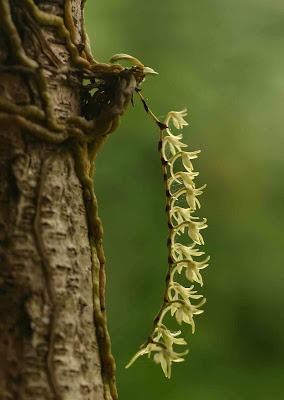Angraecopsis amaniensis is found in Kenya, Malawi, Mozambique, Tanzania, Zambia, and Zimbabwe. It grows in woodland in areas with heavy rainfall, sometimes in evergreen forests, usually at 1000-1500 m, but the plants are occasionally found as low as 750 m and as high as 2100 m.
Angraecopsis amaniensis also called as The Amani Angraecopsis, Angraecopsis tenuicalcar, is a species of the genus Angraecopsis. This species was described by Victor Samuel Summerhayes in 1945.
IDENTIFY ANGRAECOPSIS AMANIENSIS ORCHID PLANT
Angraecopsis amaniensis is found in Kenya, Malawi, Mozambique, Tanzania, Zambia, and Zimbabwe. It grows in woodland in areas with heavy rainfall, sometimes in evergreen forests, usually at 1000-1500 m, but the plants are occasionally found as low as 750 m and as high as 2100 m.
It is a small sized, warm to cold growing epiphyte with a very short stem carrying 2 to 4, narrowly elliptic, blue green, almost fleshy, sometimes deciduous leaves.
The Amani Angraecopsis blooms in the fall on a pendant, several at once, 5 to 10 cm long, densely 20 flowered inflorescence with fragrant flowers that are arranged in two rows. The flowers are pale green, star-shaped, 7–10 mm in diameter.
ANGRAECOPSIS AMANIENSIS ORCHID PLANT CARE AND CULTURE
Cultural information should only be used as a guide, and should be to be adapted to suit you. Your physical location; where you grow your plants, how much time you have to devote to their care, and many other factors, will need to be taken into account. Only then can you decide on the cultural methods that best suit you and your plants.
Light:
Angraecopsis amaniensis needs a light level of 18000-25000 lux. Light should be filtered or diffused, and plants should not be exposed to direct midday sun. Strong air movement should be provided at all times.
Temperature:
Summer days temperature at average 25-26°C, and nights average 16°C, with a diurnal range of 9-10°C. The warmest season occurs in spring at the end of the long winter dry season. Spring days at average 26-28°C, nights warm from 9-15°C, and the diurnal range falls from 17-13°C during the season.
Humidity:
The Amani Angraecopsis need the humidity of 75-85% in summer and early autumn, dropping gradually to near 50% in early spring at the end of the dry season.
Substrate, growing media and repotting:
Angraecopsis amaniensis are best grown mounted on cork or rough-barked slabs. If mounted, however, humidity must be high and the plants watered at least daily while actively growing. Several waterings a day may be necessary during extremely hot, dry weather.
If providing sufficient moisture for slab-grown plants is a problem, they may be grown in shallow baskets filled with a coarse, open, fast-draining medium that allows the roots to dry rapidly after watering. Undersized containers with room for only 1-2 year's growth should be used because the medium in larger pots remains wet for too long after watering. This does not allow the roots to dry fast enough, and they may eventually be lost to root rot.
Repotting or dividing should be done only when new root growth is just starting. This allows the plant to become reestablished in the shortest possible time with the least amount of stress.
Watering:
Rainfall in the habitat is heavy in summer and early autumn. Averages then drop rather rapidly into a dry season that extends from mid-autumn to early spring. Cultivated plants should be watered heavily while actively growing, but drainage must be excellent with good aeration around the roots. Conditions around the roots should never become stale or soggy. Water should be gradually reduced in autumn after new growths have matured.
Fertilizer:
1/4-1/2 recommended strength, applied weekly when plants are actively growing. You can use a high-nitrogen fertilizer from spring to midsummer, and then switch to one high in phosphates in late summer and autumn.
Rest period:
Winter days temperature at average 22-24°C, and nights average 5-6°C, with a diurnal range of 17-18°C. Although plants in the wild obviously survive brief exposures to temperatures below freezing, cultivated plants are probably healthier if not exposed to such extreme conditions. If plants are subjected to cold conditions, they will survive with less damage if they are dry at the time.
Water should be greatly reduced for Angraecopsis amaniensis plants in winter with fairly regular early morning mistings provided between rather infrequent light waterings in autumn and early winter. In late winter, however, water should be reduced further with only occasional mistings between infrequent waterings. Water should be increased somewhat if leaves shrivel or show other signs of stress. Fertilizer should be eliminated until new growth starts and heavier watering is gradually resumed in spring.















COMMENTS